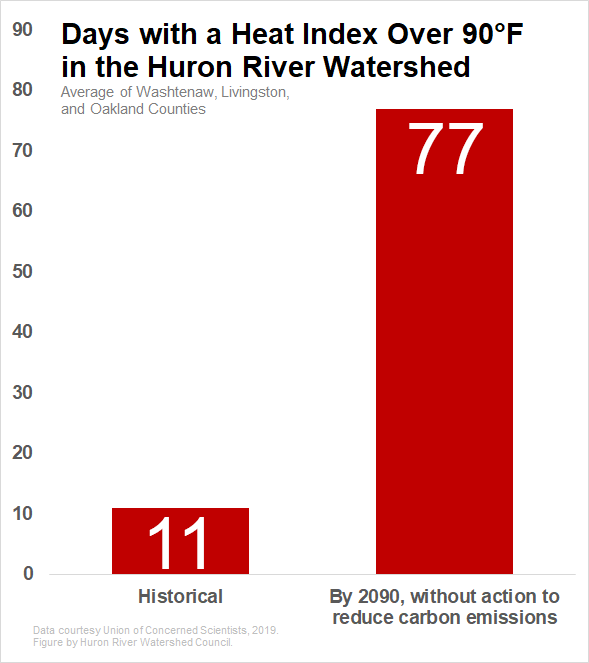Climate change is making heat waves like the one we just experienced more likely in southern Michigan, and that puts additional stress on our rivers.
As temperatures warm, the chance of having really hot days increases. That makes sense. But climate change is also increasing the number of extreme weather events. As the world warms, energy builds up in the atmosphere. Like a slinky stretched far from its resting state, the energy released in weather patterns can be more intense and less predictable. One way we see that increased variability is through the outbreak of heat waves.
More Hot Days Ahead

Washtenaw, Livingston, and Oakland Counties historically sweat through about 11 days per year where the heat index exceeds 90°F. Without action to reduce carbon emissions that warm the planet, the Huron River watershed will see around 77 days with a heat index over 90°F by the end of the century. Heat waves are also getting longer and temperatures at night aren’t providing the cooling relief they once did. That puts many people in the Huron River watershed, especially the elderly, people with asthma, and those without access to air conditioning at greater risk.
Stresses on Fish and Wildlife
Extreme heat increases stresses on water quality and wildlife too. Prolonged warm periods slow down how our rivers and lakes exchange energy with the air. With less air exchange, the amount of oxygen in the water becomes depleted, and that increases the chances of toxic algae blooms.
Over the course of a season or many seasons, warmer temperatures also displace cold-water species. Especially in creeks or shallow stretches of the river that warm faster, intense or more frequent heat waves force fish and other wildlife to find cooler spots. When they can’t, they lose their advantage over species suited for warmer waters. Over time, that reduces biodiversity, weakens the ecosystem, and makes it easier for invasive species to gain a foothold.
What HRWC is Doing
There are ways we can help our cold-water native species adapt to climate change. By protecting natural areas and forests along rivers and creeks, we can provide fish and wildlife places of shade and respite. These buffers also act to infiltrate and absorb stormwater runoff that is warmed by heat from pavement. We can use several techniques to slow or quicken the pace of flowing water in different areas, improving oxygen exchange with the atmosphere. Removing dams is the most effective strategy when it’s feasible. Relieving the river of a major obstruction restores a free-flowing waterway, helps keep waters cool and avoids many of the conditions that lead to algae blooms.
HRWC has been working to make the Huron more resilient to the impacts of climate change for many years. Rebecca Esselman has been leading our efforts on this front. You can learn more from her about our strategies in this video or learn more at our Climate Change program landing page.



